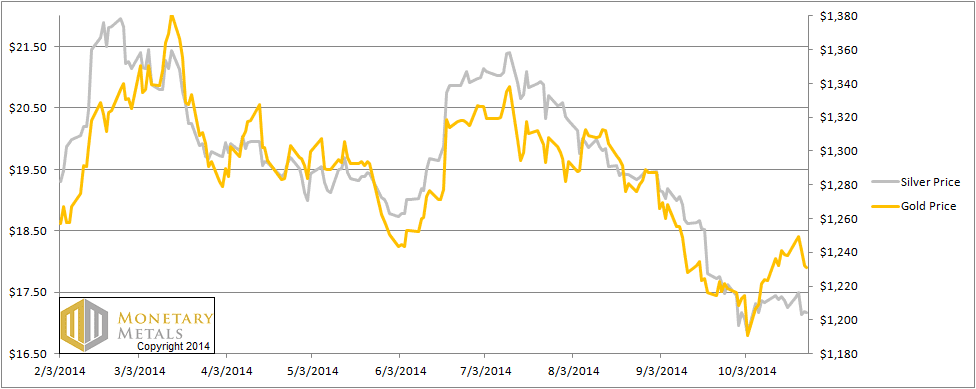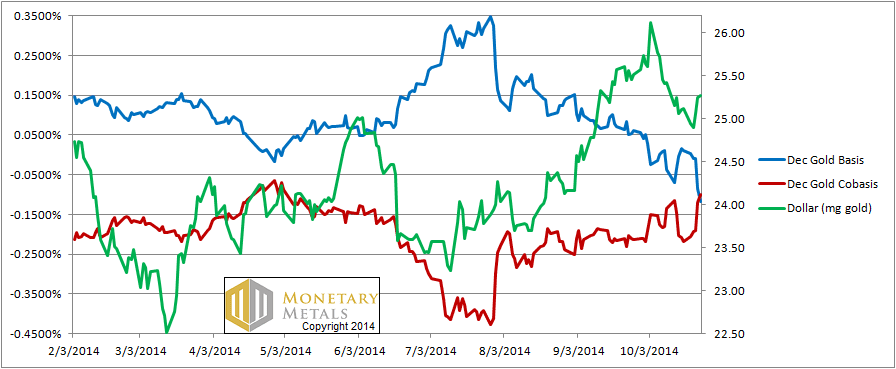Monetary Metals Supply and Demand Report: 26 Oct, 2014
On Monday and Tuesday, the hopes of the gold and silver speculators were raised. Early on Tuesday morning (Arizona time) the gold price hit $1,255 and the silver price was $17.66. But by Friday’s close, the prices were down from last week by seven bucks and 8 cents, respectively. Silver, in particular, is developing a trend (discussed below).
In Russia, by contrast, the metals were up sharply. Gold gained ₽1,295 and silver went up ₽19. Russians are getting rich on the metals, whereas Americans are not.
Of course, we’re being facetious. The ruble has dropped 20% in the last 4 months alone. Those Russians who had the foresight to trade their rubles for money—rubles are the failing credit of the Bank of Russia, and money is gold (and silver)—have not suffered the ongoing losses of their comrades. They aren’t getting rich, just keeping even.
We believe we’ve made the point clear: gold does not go anywhere. It’s the dollar that goes up and down like a yoyo, but more down than up. The dollar is down from 1555mg gold in 1913 to 25.27mg today. We promise to stop beating this dead horse for a while.
Silver does go up and down, but we have to measure it in gold to see it accurately. The gold to silver ratio is is this measure, or rather the inverse. The ratio is the number of ounces of silver you need to buy an ounce of gold.
Last week, we reiterated our call for the gold to silver ratio to hit 75. This week, it closed around the same level as last week. However, on Wednesday it hit almost 72.5. Though there is no fundamental supply-and-demand reason for it to drop, it feels like we’re due for a sharp little spike in the silver price. Maybe the next time Janet Yellen is in the news, speculators could bid silver up to $18.35 and gold up to $1,260, giving us a ratio of 68 and change. Who knows, and we don’t make bets like that.
What’s next, particularly in silver? Read on…
First, here is the graph of the metals’ prices.
We are interested in the changing equilibrium created when some market participants are accumulating hoards and others are dishoarding. Of course, what makes it exciting is that speculators can (temporarily) exaggerate or fight against the trend. The speculators are often acting on rumors, technical analysis, or partial data about flows into or out of one corner of the market. That kind of information can’t tell them whether the globe, on net, hoarding or dishoarding.
One could point out that gold does not, on net, go into or out of anything. Yes, that is true. But it can come out of hoards and into carry trades. That is what we study. The gold basis tells us about this dynamic.
Conventional techniques for analyzing supply and demand are inapplicable to gold and silver, because the monetary metals have such high inventories. In normal commodities, inventories divided by annual production can be measured in months. The world just does not keep much inventory in wheat or oil.
With gold and silver, stocks to flows is measured in decades. Every ounce of those massive stockpiles is potential supply. Everyone on the planet is potential demand. At the right price. Looking at incremental changes in mine output or electronic manufacturing is not helpful to predict the future prices of the metals. For an introduction and guide to our concepts and theory, click here.
Next, this is a graph of the gold price measured in silver, otherwise known as the gold to silver ratio.
The Ratio of the Gold Price to the Silver Price
For each metal, we will look at a graph of the basis and cobasis overlaid with the price of the dollar in terms of the respective metal. It will make it easier to provide terse commentary. The dollar will be represented in green, the basis in blue and cobasis in red.
Here is the gold graph.
The Gold Basis and Cobasis and the Dollar Price
The gold cobasis (i.e. scarcity) is up and so is the dollar (i.e. the price is down). It’s just speculators repositioning, and if anything, the fundamental price of gold has dropped a few dollars (though still above the market price).
Now let’s look at silver.
The Silver Basis and Cobasis and the Dollar Price
The dollar rose a bit in silver terms, but the cobasis fell, now down to -0.16%. When the cobasis moves opposite to the dollar price, it shows it’s not just speculators repositioning, but a change in the supply and demand fundamentals. Physical silver metal is, once again, coming to market.
The fundamental price of silver is down almost half a dollar and it’s way below the market price. We would name the number, but we don’t want to encourage hate mail.
Keith would love to meet readers face to face at The Gold Standard Institute’s event The Gold Standard: Both Good and Necessary, in Manhattan on Nov 1. There hasn’t been a real recovery from the crisis of 2008. The reason is not simply that the Fed has made a particular mistake. The cause of the crisis is the dollar itself. There will not be a recovery until we return to the use of gold as money. Please come to this talk to hear his diagnosis of the dollar and urgent prescription for gold.
© 2014 Monetary Metals







Hi Keith,
May we ask how you compute the fundamental price of the metals or is that proprietary? It would be interesting to be able to track it.
Keith,
Thanks for posting this report on Sunday before the Globex opening. I hope that you will continue with this schedule.
Hi Keith,
it seems gold is on its way to backwardation. Do you have a definition of the fundemantal price?
I will hazard a guess that there is information embedded in the Basis/Cobasis spread: in Gold, the rising USD has been accompanied by a convergence, in Silver, this has yet to happen. You can see the way this appears to play out by looking at the Gold chart in April and since August
If I am right, then the currently inverted Silver Basis/Cobasis relationship should at least reset to zero, and if you scale the magnitude of such a correction on the RH y-axis, you will see that the corresponding price movement would be 1.81mg at present to around 1.91 mg, giving a per oz price of $16.28 or lower
I have no idea if this is how Keith comes up with his “fundamental price”, but the inverted Basis/Cobasis in Silver is both apparent and anomalous
“We would name the number, but we don’t want to encourage hate mail.” – By stifling yourself due to hateful people, you punish the benevolent (but silent) majority.
Regardless of that, and to help my understanding of your work, I would appreciate a few conceptual sentences about how/why the fundamental price would differ from the current market price. Especially given the absence (or at least, unimportance) of market manipulation etc.
Here is a lame attempt at deconstructing the different performance patterns of the Basis/Cobasis in Gold and Silver: I have no idea if this analysis is valid, and I offer it solely as a means to spark debate. All technical references are to https://monetary-metals.com/introduction-to-the-monetary-metals-supply-and-demand-report/
Gold
As the Dollar has risen from July onwards, the Cobasis has risen and the Basis has fallen, to the point that whilst both are still negative, they are now approximately the same value.
What does this mean? If the Basis is falling, then that implies that Future(bid) – Spot(ask) is decreasing. My interpretation is that this reflects weakness in speculative demand – we know that Spot (ask) price of Gold has come down because the mg price of the USD has increased, so my suspicion is that the Future(bid) must have come down faster still. And Cobasis rising? – this indicates that Spot(bid) – Future(ask) is increasing, and as we know that Future(ask) is down, then that must surely mean that Spot(bid) has not fallen as rapidly.
Taken together, therefore, whilst during the Summer it was commercially viable to Carry Gold (i.e. Buy Spot and Deliver into the Futures) but not to Decarry it, right now it is not attractive to do either. If the Spot(bid) has remained relatively firm and Spot (ask) has not fallen excessively, then the observable change in Market Sentiment is in the Futures market. My take is therefore that what we have witnessed is the speculative froth coming out of the market, whilst “hoarder” demand for underlying physical remains relatively firm. How firm? Well, whilst the scale on Keith’s chart is a bit small to read accurately, it looks like the Basis and Cobasis lines may have crossed over slightly, and that the “correction” in sentiment may have overshot a little
Silver
For most of this year it was massively profitable to Carry Silver – buy it Spot and sell it into the Futures delivery; that arb really took off when the USD fell during June and early July, but by September it had run out of steam, and earlier this month it became unprofitable. The turning point appears to have been when the USD started rallying again during July, and that signal was picked up and tracked pretty faithfully by the Cobasis, to the point where it is no borderline viable to sell Silver Spot and buy it back again via the Futures delivery mechanism. This, of course, is very different from the situation in Gold
Two anomalous things appear to have happened in late September/early October: firstly, the massive unwind of now-unattractive Carry trades caused the Basis and Cobasis lines to cross over, and the relationship to invert. This didn’t happen in Gold either (although it might perhaps be about to). Secondly, whilst the Silver Basis continued to drop, the Cobasis decoupled from the USD Price trend and dropped back into negative territory even though the USD price has stabilised. There is now no commercial incentive to either Carry or Decarry Silver
Why is this? As with Gold, if the Basis is falling, then that implies that Future(bid) – Spot(ask) is decreasing and my interpretation is that this reflects weakness in speculative demand; this would explain why the commercial attractions of Carrying fell off a cliff, because the Future Bid was collapsing. But what about the Silver Cobasis? This did the “right” thing when the USD started to rally in June, and as with Gold the rising Cobasis indicates that Spot(bid) – Future(ask) is increasing. However, once the Carry trade became unprofitable (negative Carry), the Cobasis ran out of steam and decoupled from its previous trend. Why? Presumably the Spot(bid) – Future(ask) stopped increasing (and even retreated a bit), and as we know that Spot (bid) was down due to the rising USD/falling Silver price, the conclusion must surely be that the Future (ask) was particularly well offered: speculators were closing their long Futures positions in a hurry
So, what next? Well, if I am even approximately right in my facile analysis above – and to be frank, its fairly futile without access to the underlying Bid/Offer data – then a correction back towards some form of equilibrium for Silver would see the 0.5% per annum difference between Basis and Cobasis collapse. With the USD remaining firm, it;s unlikely that the Cobasis will go down in a hurry (although it decoupled from the green line, it does now at least appear to have stabilised in parallel with it), so the obvious candidate is for the Basis to rise from -0.8% to around -0.2%. To do this Future(bid) – Spot(ask) would need to increase, but with Future (bid) being an economically unattractive option for a Speculator (technical downtrend on the charts, continuing economic weakness depressing most commodities, marginally negative Decarry incentive) it appears that it will be Spot (ask) which needs to come down quite a bit, and that this will occur once the temporary “hoarders” – warehouses – dump their loss-producing physical holdings into the market.
How far could it go? Who knows, but if you look at the chart in September, a 0.6% movement in the basis appears to correspond to about a 10mg blip in the USD, which if you divide it into 31.1 grammes in an ounce suggests further downside potential of around US$0.90 per oz down to something like $16.28
I have absolutely no idea if this analysis is valid, and I sincerely hope that Keith or anyone else with a more informed or more lucid insight will please step in to correct me. However, something clearly happened in Silver at the start of this month, and the Basis/Cobasis relationship is now upside-down, which is surely begging for a correction
I don’t know how to respond to what has happened since I wrote the above, and am more than happy to write it off as just getting lucky. Lord knows, that would be a rare enough event in its own right and I’d be quite content to take it at face value
But COME ON! The whole point of my Comment was to spark a debate, and although I feel sure that at least someone must have read what I wrote, nobody has challenged or corrected it. CLEARLY there is something going on here, and my only hope is that Keith’s update on Monday will throw some light on what is behind the most recent move. I will gladly declare myself a total idiot if my banal analysis turns out to have played no part in the recent collapse in Silver, but given the wealth of information and knowledge available on this and other websites, and I really the only one who has an opinion – informed or otherwise – on this?
There is no shame in being wrong – we are all fumbling around in the dark here – but neither is there shame in being right (for once) – where are all of you on this? What do YOU think is driving this price movement? Rather than just badgering Keith for the keys to his Crystal Ball, why don’t you hazard a guess (as I have done), or at least have the decency to challenge or correct me. As it is, I am now more confused than ever, and can’t wait for Monday to find out what actually happened
well, it seems I was indeed misguided (and just lucky in my prediction) – the most recent analysis shows a distinct widening in the Basis – Cobasis spread, rather than what I had imagined would be a correction
I remain baffled, but convinced there is some information embedded in it somewhere – else, why is it moving?
I 2nd everything tjmmz9843 said!